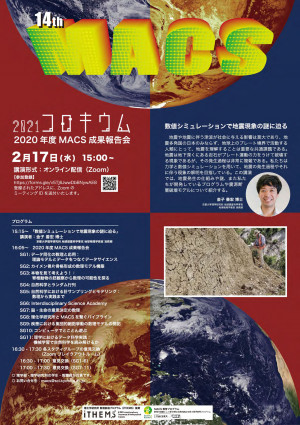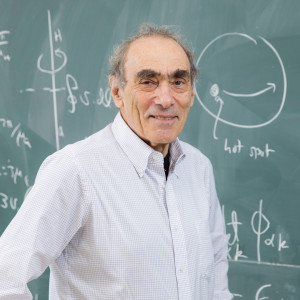Volume 136
Back to Newsletter List
Press Release
Untangling the complexity of market competition in consumer goods—A complex Hilbert PCA analysis
2021-02-04
A research collaboration of Prof. Makoto Mizuno (the Faculty of Commerce, Meiji University), Prof. Hideaki Aoyama (Senior Visiting Scientist, RIKEN iTHEMS) and others has developed a new econophysics method applicable to analyze marketing data.
For more details, please see the related links.
Reference
- Makoto Mizuno, Hideaki Aoyama, Yoshi Fujiwara, Untangling the complexity of market competition in consumer goods—A complex Hilbert PCA analysis, PLOS ONE 16(10): e0258600 (2021), doi: 10.1371/journal.pone.0245531
Seminar Report
iTHEMS Theoretical Physics Seminar by Prof. Nobutoshi Yasutake on January 28, 2021
2021-01-29
On January 28, the iTHEMS-phys seminar entitled "Many body problems from quarks to stellar evolutions" given by Prof. Nobutoshi Yasutake (Chiba Institute of Technology/JAEA) was held. He has been working for the stelar evolutions as gravitational many-body problems and the hadronic matter as quantum many-body problems based on the Lagrangian schemes. Recently, he discussed hadronic matters properties using the color molecular dynamics.
The seminar was held via the Zoom online conference systems. Around 20 people, including outside from iTHEMS, attended the seminar. The discussion was quite lively, and it was continued more than one hour even after the seminar.
Many body problems from quarks to stellar evolutions
January 28 (Thu) 13:30 - 15:00, 2021
Upcoming Events
Workshop
Co-hosted by iTHEMS
The 12th RIKEN-Kyoto University Joint Data Assimilation Workshop
February 10 (Wed) 13:30 - 16:30, 2021
Language: Japanese/English
Participation deadline: Tuesday, February 9, 2021
Venue: via Online
Event Official Language: Japanese
Seminar
iTHEMS Biology Seminar
A machine learning approach for prediction of mitochondrial proteins in non-model organisms
February 12 (Fri) 10:00 - 11:00, 2021
Keitaro Kume (Assistant Professor, Faculty of Medicine, University of Tsukuba)
The evolution of the repertoire of proteins localized to organelles is important for understanding the evolutionary process of organelles. However, experimental methods for identifying organelle-localized proteins have been established only for model organisms and some organisms. Therefore, prediction methods using sequence data obtained from genome and transcriptome analyses, which are relatively easy to obtain, are useful. However, such prediction methods had also been established only for model organisms. In this talk, I will introduce our study in which a machine learning method was used to obtain protein candidates localized to mitochondrion-related organelles in non-model organisms.
Reference
- K. Kume et al., Evol. Bioinform. 14:1176934318819835. (2018)
Venue: via Zoom
Event Official Language: English
Seminar
iTHEMS Theoretical Physics Seminar
Quantum mechanical description of energy dissipation and application to heavy-ion fusion reactions
February 16 (Tue) 13:00 - 14:30, 2021
Masaaki Tokieda (Ph.D. Student, Department of Physics, Graduate School of Science, Tohoku University)
For theoretical description of heavy-ion fusion reactions, two different models have been used depending on the incident energy. At energies above the Coulomb barrier, importance of energy dissipation and fluctuation has been deduced from scattering experiments. To describe them phenomenologically, the classical Langevin equation has successfully been applied. At energies below the Coulomb barrier, on the other hand, the quantum coupled-channels method with a few number of internal states has been applied, and it has succeeded in explaining sub-barrier fusion reactions. While each method succeeds in each energy range, a unified description of heavy-ion fusion reactions from sub-barrier energies to above barrier energies is still missing. To achieve this, we need to treat dissipation and fluctuation quantum mechanically.
In order to describe dissipation and fluctuation quantum mechanically, we have applied ideas of open quantum systems to heavy-ion fusion reactions. I will talk about recent development in this talk. First I will introduce a model Hamiltonian to treat dissipation and fluctuation quantum mechanically, and explain its character and a strategy for numerical studies. I will then apply the model to a fusion problem, and discuss a role of energy dissipation during quantum tunneling. Finally I will discuss a possible future direction for a unified description of heavy-ion fusion reactions.
Venue: via Zoom
Event Official Language: English
Seminar
DMWG Seminar
Mapping the Milky Way by VLBI Astrometry
February 16 (Tue) 13:30 - 15:00, 2021
Nobuyuki Sakai (Korea Astronomy and Space Science Institute (KASI), Republic of Korea)
Astrometry is the only way to obtain 6D (position-velocity) phase space information for astronomical objects. The unique capability allows us to examine the past, present, and future of the Milky Way.
Firstly, I will introduce history and basics of astrometry. Secondly, I will overview astrometric projects in the world. Thirdly, I will highlight recent astrometric results about the Galactic structure. Lastly, I will introduce astrometric research in Korea as well as future astrometric projects and sciences in 2020s and 30s.
Venue: via Zoom
Event Official Language: English
Conference
Co-hosted by iTHEMS
Blockchain in Kyoto 2021
February 17 (Wed) - 18 (Thu) 2021
Language: Some parts will be in Japanese.
The International Conference on Blockchains and their Applications aims at bringing together researchers and practitioners from various communities of science and technology working on areas related to FinTech, Crypto-asset, and Blockchain.
For more information, please refer to the related links.
Venue: Hybrid Format (International Conference Room I, Clock Tower Centennial Hall, Kyoto University and Online)
Event Official Language: English
Colloquium
MACS ColloquiumSupported by iTHEMSSUURI-COOL (Kyoto)
The 14th MACS Colloquium
February 17 (Wed) 15:00 - 17:30, 2021
Yoshihiro Kaneko (Associate Professor, Division of Earth and Planetary Sciences, Graduate School of Science, Kyoto University)
15:00- Talk by Prof. Yoshihiro Kaneko
16:05- MACS Report Meeting FY2019
16:30- Discussion of each study group
Venue: via Zoom
Event Official Language: Japanese
Seminar
ABBL-iTHEMS Joint Astro Seminar
The Evolution of Primordial Neutrino Helicities under Gravitational and Magnetic Fields and Implications for their Detection
February 22 (Mon) 10:00 - 11:30, 2021
Gordon Baym (Senior Visiting Scientist, RIKEN Interdisciplinary Theoretical and Mathematical Sciences Program (iTHEMS) / Professor Emeritus, University of Illinois, USA)
Feb.22 (Mon) 10:00am-11:30am (JST)
Primordial neutrinos decoupled in the early universe in helicity eigenstates. As I will discuss, two effects -- dependent on neutrinos having a non-zero mass -- can modify their helicities as they propagate through the cosmos. First, finite mass neutrinos have a magnetic moment and thus their spins, but not their momenta, precess in cosmic and galactic magnetic fields. The second is the propagation of neutrinos past cosmic matter density fluctuations, which bend their momenta, and bend their spins by a smaller amount. (The latter is a general relativistic effect.) Both effects turn a fraction of left-handed neutrinos into right-handed neutrinos, and right-handed antineutrinos into left-handed. If neutrino magnetic moments approach that suggested by the XENON1T experiment as a possible explanation of their excess of low energy electron events -- a value well beyond the moment predicted by the standard model -- helicities of relic Dirac (but not Majorana) neutrinos could be considerably randomized. I finally will discuss the implications of neutrino helicity rotation, as well as their Dirac vs. Majorana nature, on their detection rates via the Inverse Tritium Beta Decay reaction.
Reference
Venue: via Online
Event Official Language: English
Paper of the Week
Week 1 of February
2021-02-04
Title: Twisted crystallograpic T-duality via the Baum--Connes isomorphism
Author: Kiyonori Gomi, Yosuke Kubota, Guo Chuan Thiang
arXiv: http://arxiv.org/abs/2102.00393v1
Title: Most charming dibaryon near unitarity
Author: Yan Lyu, Hui Tong, Takuya Sugiura, Sinya Aoki, Takumi Doi, Tetsuo Hatsuda, Jie Meng, Takaya Miyamoto
arXiv: http://arxiv.org/abs/2102.00181v1
Title: Time to revisit the endpoint dilution assay and to replace TCID50 and PFU as measures of a virus sample's infection concentration
Author: Daniel Cresta, Donald C. Warren, Christian Quirouette, Amanda P. Smith, Lindey C. Lane, Amber M. Smith, Catherine A. A. Beauchemin
arXiv: http://arxiv.org/abs/2101.11526v1
Person of the Week
Self-introduction: Björn Ahlgren
2021-02-04
My name is Björn Ahlgren. I joined iTHEMS as a visiting scientist in February 2021 as part of my current postdok, and I'm otherwise based at KTH in Stockholm, Sweden. My field of research is astrophysics, where I work mainly on gamma-ray bursts (GRBs), which are some of the most violent explosions in the Universe. These phenomena are caused by the collapse of particularly massive stars, and by compact object binary mergers, and they can serve both as laboratories for physics under extreme conditions, as well as probes of the early Universe. In my research I focus on the intersection between theory and observations, where I try to develop and reconcile theoretical models for the emission mechanisms of GRBs with the best available observations, using statistical methods. My specialisation lying in applied statistics, I really enjoy interdisciplinary projects where I get to work with new ideas and new data. I'm excited to join iTHEMS and I hope I will get the opportunity to engage in new collaborations across different disciplines.
If you would like to cancel your subscription or change your email address,
please let us know via our contact form.
Copyright © iTHEMS, RIKEN. All rights reserved.






